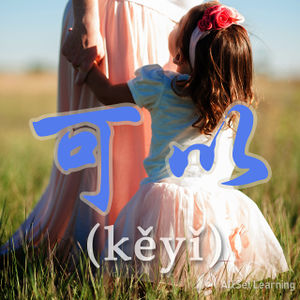Difference between revisions of "Expressing permission with "keyi""
m (Text replacement - "Māmā" to "Māma") |
m (Text replacement - "{{HSK|HSK2}}" to "{{HSK|HSK2}}{{2021-HSK|HSK2}}") |
||
| (11 intermediate revisions by 5 users not shown) | |||
| Line 22: | Line 22: | ||
* 我 <em>可以</em> 进来 吗?<span class="pinyin">Wǒ <em>kěyǐ</em> jìnlái ma?</span><span class="trans">May I come in?</span> | * 我 <em>可以</em> 进来 吗?<span class="pinyin">Wǒ <em>kěyǐ</em> jìnlái ma?</span><span class="trans">May I come in?</span> | ||
| − | * 二十 一 岁 以后 <em>可以</em> | + | * 二十 一 岁 以后 <em>可以</em> 喝酒。<span class="pinyin">Èrshí-yī suì yǐhòu <em>kěyǐ</em> hējiǔ.</span><span class="trans">After you are 21 years old, you may drink alcohol.</span> |
* 妈妈,我 <em>可以</em> 出去 玩 吗?<span class="pinyin">Māma, wǒ <em>kěyǐ</em> chūqù wán ma?</span><span class="trans">Mom, may I go out and play?</span> | * 妈妈,我 <em>可以</em> 出去 玩 吗?<span class="pinyin">Māma, wǒ <em>kěyǐ</em> chūqù wán ma?</span><span class="trans">Mom, may I go out and play?</span> | ||
* 我们 <em>可以</em> 在 办公室 吃饭 吗?<span class="pinyin">Wǒmen <em>kěyǐ</em> zài bàngōngshì chīfàn ma?</span><span class="trans">Can we eat in the office?</span> | * 我们 <em>可以</em> 在 办公室 吃饭 吗?<span class="pinyin">Wǒmen <em>kěyǐ</em> zài bàngōngshì chīfàn ma?</span><span class="trans">Can we eat in the office?</span> | ||
| Line 29: | Line 29: | ||
</div> | </div> | ||
| − | == Negating 可以 | + | == Negating 可以 (kěyǐ) Sentences == |
可以 (kěyǐ) sentences are [[Standard negation with "bu"|negated with 不 (bù)]], which is inserted before 可以 (kěyǐ). | 可以 (kěyǐ) sentences are [[Standard negation with "bu"|negated with 不 (bù)]], which is inserted before 可以 (kěyǐ). | ||
| Line 45: | Line 45: | ||
<div class="liju"> | <div class="liju"> | ||
| − | * | + | * 孩子 <em>不 可以</em> 看 这 个。<span class="pinyin">Háizi <em>bù kěyǐ</em> kàn zhège.</span><span class="trans">Children can't watch this.</span> |
* 你 现在 <em>不 可以</em> 进去。<span class="pinyin">Nǐ xiànzài <em>bù kěyǐ</em> jìnqù.</span><span class="trans">You can't go in right now.</span> | * 你 现在 <em>不 可以</em> 进去。<span class="pinyin">Nǐ xiànzài <em>bù kěyǐ</em> jìnqù.</span><span class="trans">You can't go in right now.</span> | ||
* 这里 <em>不 可以</em>抽烟。<span class="pinyin">Zhèlǐ <em>bù kěyǐ</em> chōuyān.</span><span class="trans">You can't smoke here.</span> | * 这里 <em>不 可以</em>抽烟。<span class="pinyin">Zhèlǐ <em>bù kěyǐ</em> chōuyān.</span><span class="trans">You can't smoke here.</span> | ||
| Line 60: | Line 60: | ||
== Sources and further reading == | == Sources and further reading == | ||
| − | + | {{Source|HSK Standard Course 2|34}} | |
| − | + | {{Source|New Practical Chinese Reader 1 (新实用汉语课本1)|160-1}} | |
| − | + | {{Source|New Practical Chinese Reader 1 (新实用汉语课本1)(2nd ed)|185-7}} | |
| + | {{Source|A Practical Chinese Grammar For Foreigners (外国人实用汉语语法)|44}} | ||
[[Category:A1 grammar points]] | [[Category:A1 grammar points]] | ||
| + | {{HSK|HSK2}}{{2021-HSK|HSK2}} | ||
{{Used for|Expressing ability}} | {{Used for|Expressing ability}} | ||
{{Used for|Requesting}} | {{Used for|Requesting}} | ||
Latest revision as of 08:54, 21 April 2021
-
Level
-
Similar to
-
Used for
-
Keywords
可以 (kěyǐ) is an auxiliary verb primarily used for expressing permission. It's often translated as "can," but in order to not get it confused with other words, it's best to think of it as "may" to emphasize the permission aspect.
Contents
Basic Usage
Just put 可以 (kěyǐ) in directly before a verb to create a meaning of "may" (plus the verb). It's the same structure whether it's a statement or a question.
Structure
Subj. + 可以 + Verb + Obj.
Use this structure to express permission to do things.
Examples
- 我 可以 进来 吗?May I come in?
- 二十 一 岁 以后 可以 喝酒。After you are 21 years old, you may drink alcohol.
- 妈妈,我 可以 出去 玩 吗?Mom, may I go out and play?
- 我们 可以 在 办公室 吃饭 吗?Can we eat in the office?
- 我 可以 在 这里 停车 吗?Can I park here?
Negating 可以 (kěyǐ) Sentences
可以 (kěyǐ) sentences are negated with 不 (bù), which is inserted before 可以 (kěyǐ).
Structure
Subj. + 不 + 可以 + Verb + Obj.
Examples
- 孩子 不 可以 看 这 个。Children can't watch this.
- 你 现在 不 可以 进去。You can't go in right now.
- 这里 不 可以抽烟。You can't smoke here.
- 我们 都 不 可以 去 。None of us may go.
- 你 不 可以 说 脏话。You can't say swear words.
See also
- Expressing ability or possibility with "neng"
- Comparing "hui" "neng" "keyi"
- Expressing a learned skill with "hui"
Sources and further reading
- HSK Standard Course 2 (pp. 34) Anything Goes (无所不谈) →buy
- New Practical Chinese Reader 1 (新实用汉语课本1) (pp. 160-1) Anything Goes (无所不谈) →buy
- New Practical Chinese Reader 1 (新实用汉语课本1)(2nd ed) (pp. 185-7) Anything Goes (无所不谈) →buy
- A Practical Chinese Grammar For Foreigners (外国人实用汉语语法) (pp. 44) Anything Goes (无所不谈) →buy



